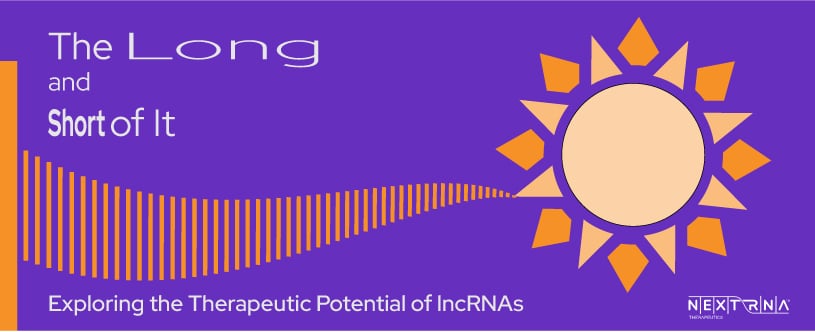Let’s start with the basics. At a very high level, how would you explain lncRNAs and their function?
LncRNAs fulfill a plethora of functions in cell biology and gene regulation. Many if not most are derived from genetic loci called enhancers that nucleate subnuclear and cytoplasmic domains to guide the epigenetic trajectories of development by interaction with chromatin-modifying proteins. Antisense lncRNAs appear to have an important role in regulating alternative splicing.
Obviously, the world has heard a lot of about mRNA in the past three years. It’s become a ‘household name’ of sorts because of the COVID vaccines. How does lncRNA relate to mRNA?
mRNAs encode proteins, although they may also have regulatory functions – an estimated 17% of protein-coding genes express a lncRNA (by alternative splicing) as their major product. Many lncRNAs are multiexonic, highly alternatively spliced, 5’ capped and 3’ polyadenylated, just like mRNAs. Many others are processed from intronic RNAs.
Proteins are just the parts set. The human genome encodes approximately the same number of protein coding genes (about 20,000) as a simple nematode worm with only 1,000 cells, most of which have similar functions. The difference is the extensive use of lncRNAs to orchestrate a more complex developmental plan that places ~30 trillion cells into the right arrangements in a human, with a myriad of precisely sculpted bones, muscles, organs, and a brain.
How do you think the mRNA space moved past initial skepticism to intense interest?
The mRNA space moved past initial skepticism to intense interest because of the success of COVID vaccines – the proof was in the pudding. However, while it raised awareness of and interest in RNA, it did little to diminish the archaic protein-centric view of genetic programming.
lncRNA is a much more nascent space than mRNA — probably where the mRNA space was about a decade ago. Do you think the potential application of lncRNA is as exciting as mRNA?
Yes, perhaps more exciting, as lncRNA control development and brain function. They are what makes us individuals and, in large part, distinguishes our species from others. There are at least 10 times more lncRNA genes than protein-coding genes, and far more isoforms.
Why do lncRNAs represent important targets? What is their therapeutic applicability?
There is increasing evidence of the involvement of lncRNAs in developmental, neurological, and neuropsychiatric disorders. Most of the genetic loci found to be associated with complex traits and diseases express lncRNAs, which are therefore prime candidates to understand the etiology of these traits and diseases, and prime targets for therapeutic intervention, using the well-established RNA interference and CRISPR technologies.
In the consensus statement published in Nature Reviews Molecular Cell Biology, you reference how some in the molecular biology community were initially suspect that lncRNAs was anything beyond transcriptional noise. What have been the biggest drivers that have shifted perceptions about lncRNAs?
The changes in perceptions about lncRNAs has largely occurred as result of their highly cell-specific and dynamic expression, and the hundreds if not thousands of studies showing their involvement in cell biology, development, cancer, and other diseases. It has also shifted because of a two-decade long campaign to convince molecular biologists to discard the primitive idea that genes = proteins and to think constructively about unexpected findings.
You also mention in the paper a recent study that low expression of lncRNAs can be essential for their functional role by ensuring target specificity. So, it seems that low expression of lncRNAs is a good thing. Was that a surprising finding?
Not really, when one considers their transient regulatory functions. Many conventional transcription factor genes are also expressed transiently and at relatively low levels.
What other surprises have lncRNAs revealed?
The main surprise, and the biggest challenge to the prevailing orthodoxy, is that the existence of lncRNAs portends a complete reevaluation of the genetic information in complex organisms.
Where do you think the lncRNA space will be in 5 years?
In 5 years, I expect that there will be a much more extensive catalog of lncRNA and lncRNA isoform expression during development, a greater understanding of their roles in enhancer function, the formation of associated phase-separated domains, the guidance of epigenetic processes and brain function, including the additional layer of dynamic RNA modifications during these processes. There will also be a much greater appreciation of the role of transposable elements in species diversification, gene regulation and environmental adaptations.
What about in 10 years?
Even more so. The 20th century was just the warmup. This century will be the century of biology and medicine, stemming from a far more complete and sophisticated understanding of the central role of RNA in evolution, development, and brain function.
What are the key steps we need to take to get there?
Accept the previous proposition, treat lncRNAs as key players in the genetic programming of development and key mediators of complex diseases, and investigate accordingly.
In 2022, Dr. Mattick published a book titled, RNA, the Epicenter of Genomic Information. It can be downloaded here.

